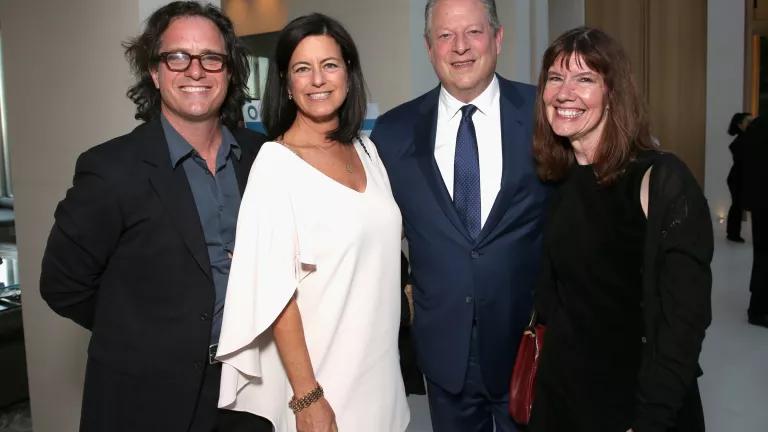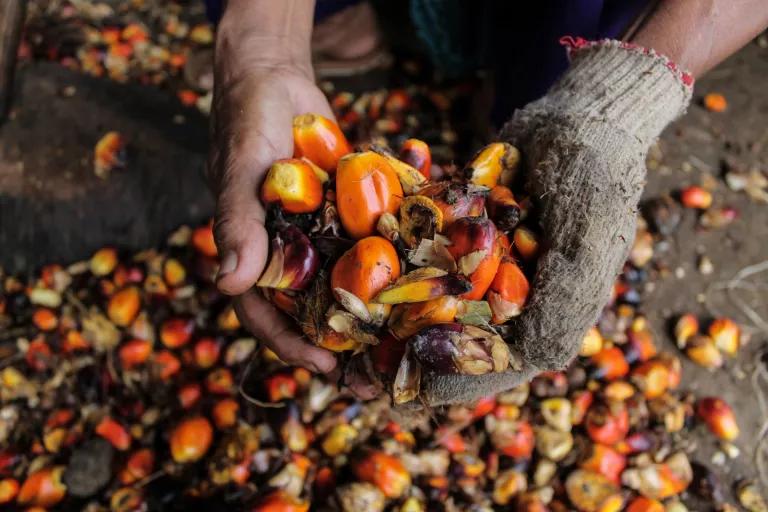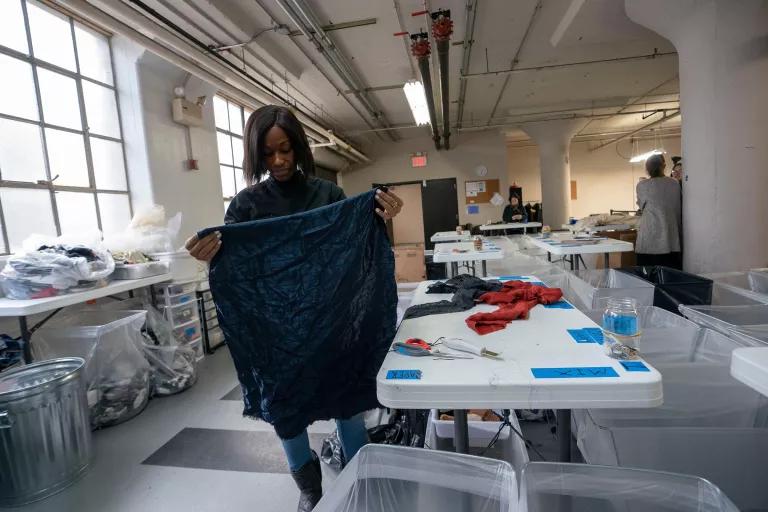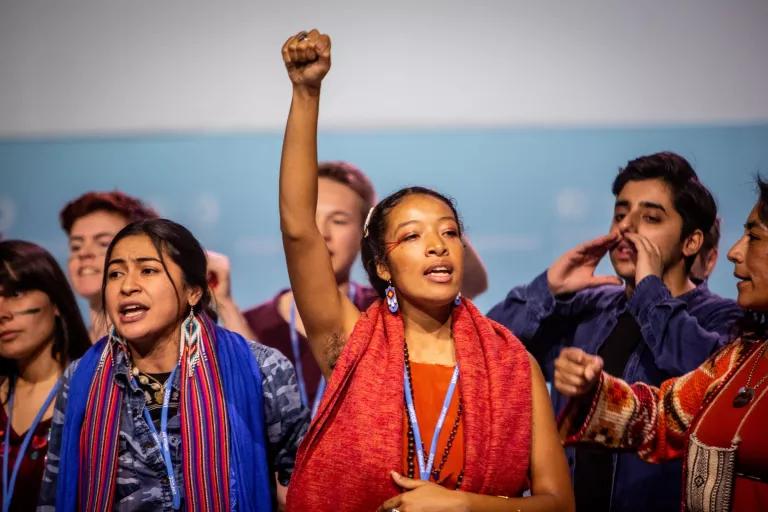Laurie David Is Keeping the Action in Climate Activism
The producer and author wants people to understand what our planet is up against, but even more than that, she wants to show us how, together, we can make real change.

For nearly 20 years now, Laurie David has made it her mission to explain—in the clearest possible terms—the existential threat posed to humanity by climate change and our continued reliance on unsustainable practices. She’s done it through documentary films (An Inconvenient Truth, Fed Up), television (Too Hot Not to Handle), and books (The Down to Earth Guide to Global Warming).
But David, an NRDC Trustee, is no alarmist. Her dedication to the issue is rooted in hope rather than despair; her message is meant to spur people to action, not to make them feel powerless. In her newest book, Imagine It!: A Handbook for a Happier Planet, David, together with coauthor Heather Reisman, breaks down this message into its component parts. Each chapter focuses on a different aspect of our current climate and sustainability crisis, delving into plastic use, transportation, chemical pollution, our deeply flawed food systems, and other topics. Readers will also find myriad suggestions and ideas for individual actions to take—not just to make themselves feel better, but to actually make things better.
At the beginning of Imagine It! you write: “Not a single person who picks up this book intentionally decided to live in a manner that contributes to environmental degradation and global warming.” Why did you feel it was important to make that statement at the outset?
Because this book isn’t about shame and blame. It's about: Okay, what do we do now? And how do we do it? That's the most important thing. The average mom, for example, doesn't want to be contributing to global warming or destroying the habitat of the orangutan by buying products made with palm oil, an ingredient that goes into so many foods but that’s also a massive source of deforestation. The world didn't set out to have this problem. At some point, climate change actually was unforeseen. But by now we’ve known about it for a long time. You can't deny it anymore; it's already upon us. We're seeing it every season—every single day, in fact. So we have to act. This book is designed to help people act.

Many books about climate change and pollution do a good job of describing the problems, but often they stop there. What motivated you to take the next step?
I'm interested in empowering people to better protect themselves—and, as a result, to better protect the planet. Because they go completely hand in hand! Everything is connected. As goes the environment, so goes our health. And I think we’re at a point in our culture where either we're not understanding that, or we're ignoring it. It’s like we're in the middle of a dysfunctional relationship with our most important partner: Mother Earth. One partner is taking and taking and taking, and not giving back. We need couple's therapy, and we need it right now. That's an example of unsustainability that I think everyone can understand.
The thing I love about this book is that you can dip in and out of it, and make the changes you want to make. You can do a chapter a week, if you like. You don't have to read it from front to back; you can skip around and meet it wherever you are.
Some readers may be surprised to see a chapter on clothing in a book about climate change and sustainability. What do you wish more people knew about the apparel industry and its impacts?
The evolution of fast fashion has been a disaster for the environment. This whole concept—that we buy cheap things to wear once or twice, and then we discard them—is insanity. As much as 85 percent of the clothes we purchase every year ends up in landfills. The manufacturing process for clothing involves 20,000 different chemicals, many of which are cancer-causing, and requires a trillion liters of water each year. During that process, those same chemicals are released into wastewater; one-fifth of the world’s industrial water pollution can be traced back to the apparel industry. And around the world, a lot of these textile factories are still being powered by coal. The industry accounts for 10 percent of our global emissions.

You suggest different ways that people can combat this problem at the individual consumer level: by purchasing vintage clothing, holding clothing-swap parties with friends, and by taking part in something called the #30WearsChallenge, which would have us asking ourselves if we can imagine wearing an item at least 30 times before we buy it. What else can individuals do?
The big changes won't happen without individual consumers demanding it from businesses. We have to start pushing them, with our dollars, to do better. Because ultimately it's not about one person doing something—it's about millions of us doing something. It's not going to happen without the collective will.
The buy-and-toss mindset is just unsustainable. We do the same thing with single-use plastics: One million plastic water bottles are purchased every minute around the globe. Human beings manage to produce 380 million tons of plastic waste every year. And because plastic never fully biodegrades, every ounce of it is still with us in some way, shape, or form. Some of it goes into the oceans, where it breaks down and gets eaten by fish—and then, later, gets eaten by us. And a great deal of it, of course, goes into landfills, where it can leach toxic chemicals into soil and groundwater supplies. These landfills are in our own backyards, and they’re disproportionately found in communities where low-income people and people of color live.
You include many examples of environmental injustice in the book. How are they tied to the problems you describe?
They’re completely interrelated. A lot of people, I think, began to connect the dots over this past year, when it became clear that people of color were disproportionately coming down with—and dying from—COVID-19. As soon as you start to scratch underneath that, it's like: Well, why wouldn’t that be the case? These are the same people who are disproportionately being exposed to air pollution, which we now know puts people at higher risk of getting sick. Where are the landfills? Where are the oil refineries? In whose neighborhoods? So much of this boils down to environmental racism.

You end the book with a chapter addressed to parents, about how to foster a sense of environmental responsibility in the next generation. What makes you feel hopeful when you think about the future?
In just the past few years, my eyes have been opened to all of the youth activists, and especially the youth activists of color, who are working on these issues. But we absolutely can’t say: "Okay, the next generation is gonna take care of it." I think a lot of people have that attitude. No. We have to do this now.
But the good news is that you can't put the toothpaste back in the tube: Once you’ve seen something—whether it’s an example of the problem or a smart solution that addresses the problem—you're forever changed. Now you’re an advocate. It's just what happens. And you pass this along to your kids, to your girlfriends, to your family members; you share the information and you spread the word. And that's how we change things. It's the collective will. It can move mountains.
This NRDC.org story is available for online republication by news media outlets or nonprofits under these conditions: The writer(s) must be credited with a byline; you must note prominently that the story was originally published by NRDC.org and link to the original; the story cannot be edited (beyond simple things such as grammar); you can’t resell the story in any form or grant republishing rights to other outlets; you can’t republish our material wholesale or automatically—you need to select stories individually; you can’t republish the photos or graphics on our site without specific permission; you should drop us a note to let us know when you’ve used one of our stories.

Heat Stress Is Killing Workers. States Can Protect Them.
When Customers and Investors Demand Corporate Sustainability
How to Make an Effective Public Comment